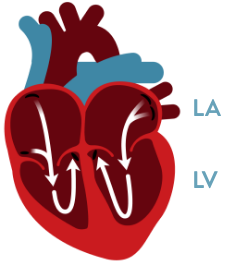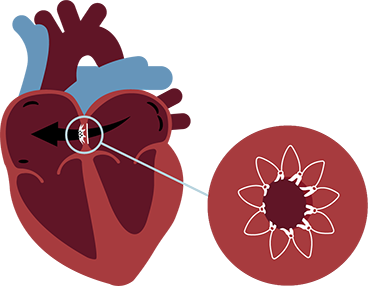
Meet the Corvia® Atrial Shunt
The most widely studied atrial shunt in heart failure.
The Corvia Atrial Shunt is an investigational cardiac device designed to reduce heart failure symptoms by decreasing pressure in the left side of the heart and the lungs.
CLINICAL EXPERIENCE
The Corvia Atrial Shunt has been evaluated in multiple clinical studies, and has been implanted in more than 550 patients in 18 countries worldwide.1
The most recent study, a 626-patient blinded, randomized trial, identified a large group of patients whose health status improved significantly after receiving the device. After one year, patients in this “responder group” had fewer heart failure events, fewer heart failure symptoms, and an improved quality of life compared to the group of patients who did not receive the shunt.2
45%
Patients who received shunt therapy had a 45% lower chance of experiencing heart failure events than patients who did not.
40%
Atrial shunt patients were 40% more likely to be free from or only have minor heart failure symptoms compared to patients who did not receive the shunt.
40%
Patients who received a shunt had a 40% greater chance of experiencing a very large improvement in their quality of life compared to patients who did not.
How it works
Let’s take a look at how the Corvia Atrial Shunt reduces symptoms associated with a certain kind of heart failure called heart failure with preserved ejection fraction (HFpEF).

In a healthy heart…
The left ventricle (LV) and left atrium (LA) relax to fill with blood from the lungs. Once filled, the left ventricle pumps blood to the body.

With HFpEF…
The muscles of the left atrium and left ventricle become stiffer and are unable to relax normally.
As a result, blood cannot easily enter the left atrium or left ventricle with each heartbeat, causing high pressure inside the lungs and left heart chambers.
This high pressure can cause shortness of breath and fatigue—common symptoms of worsening heart failure that can make daily activities challenging and even result in hospitalization.

The Corvia Atrial Shunt…
Is implanted via a minimally invasive procedure in which a physician inserts a catheter (small tube) into a vein near the groin to access the heart.
The physician then uses the catheter to create a very small passage in the heart wall, placing the shunt between the right and left atria.
This new passage allows blood to flow from the higher pressure left atrium to the lower pressure right atrium. As a result, the pressure in the left side of the heart and the lungs decreases, reducing heart failure symptoms.
BENEFITS AND RISKS
As with any medical procedure, the Corvia Atrial Shunt has potential benefits and risks. It is important that you talk with your doctor to understand the benefits and risks associated with this device.
Benefits
Potential benefits for people implanted with the Corvia Atrial Shunt as part of this study include the following:
- Less shortness of breath
- Fewer heart failure (HF) hospitalizations and/or days in the hospital for HF symptoms
- Fewer emergency room visits
- Improved exercise tolerance
- Better quality of life
Risks
The risks associated with the implant procedure are similar to the risks of other catheter based cardiac procedures in which devices are permanently implanted in the atrium or in the heart wall between the two atria. Because these procedures are routine, these potential risks are uncommon; interventional cardiologists, electrophysiologists and their staff are well trained to reduce the likelihood and manage procedural risks.
Potential but uncommon long-term device risks include movement or fracture after placement, a blood clot that forms on or near the device and travels through the heart causing a blockage of a blood vessel (embolization, infarction with potential stroke), perforation or erosion of the heart wall, headache, chest pain, heart rhythm changes, or gradual implant occlusion and return of HF symptoms. The device is intended as a permanent implant, and does not need to be removed unless there is a medical reason to do so.
